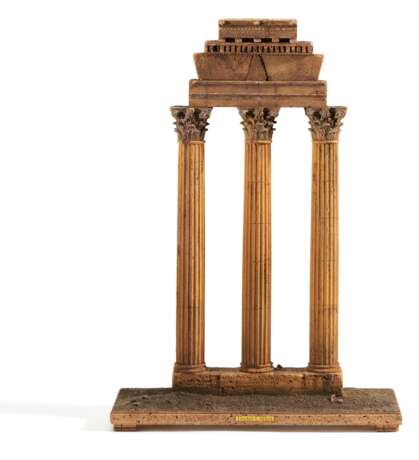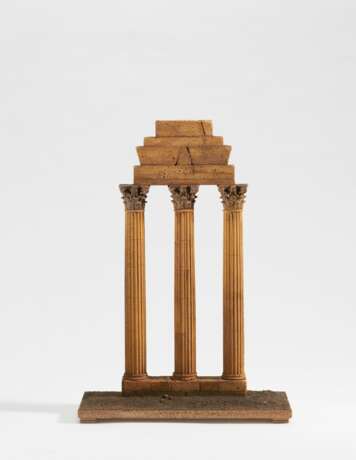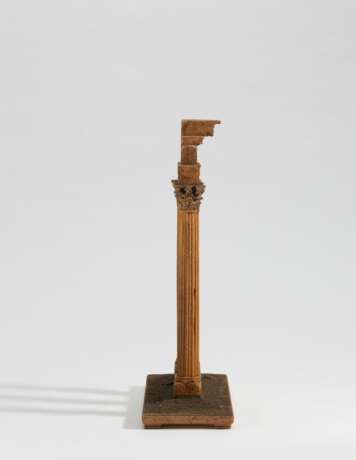ID 647768
Lot 44 | Cork model of the Temple of Castor and Pollux in Rome
Estimate value
€ 4 000 – 6 000
Cöllen, Dieter. Köln
Technique: Cork, carved and naturalistically patinated.
Description: Also rectangular plinth, the model of the preserved three columns of the Temple of
Dioscuri in honour of the twins Castor and Pollux on the Forum Romanum.
Measurement: Model in scale 1:50. Height 44,5cm, base 31,5 x 13,5cm.
Mark: Artist's signature on the front of the base.
Literature:
Freiburger, E./Goffin, A./Klotz, J. (ed.): Dieter Cöllen. Der Ruinenbaumeister,
Neulingen 2020, see another model on a scale of 1:50 on p. 126f.
"Only those who know the past have a future".
(Wilhelm von Humboldt)
"In the 18th century, cork models fired the imagination of those who had no access to the cultural sites of antiquity. At that time, they provided the basis for scientific studies and paved the way for the rapid development of classicism in architecture."
At a time when travelling was reserved for the wealthy aristocracy, cork models served as visual objects of unknown cultures and provided access to ancient architecture for all levels of society. The first small models came into circulation throug wealthy and aristocratic Englishmen, who brought them back from their "Grand Tour" as souvenirs. The material cork, with its porous texture resembling brittle stones, provides not only a precise image of reality but also a sensual vividness. The longing for something tangibly sensual, which was characteristic of the 18th century, made the models very popular and sought-after collectors' items, so that they were soon to be found in all the princely courts of Europe of the time. From today's perspective, the aspect of preserving the memory of already decayed or destroyed architecture and ruins is a major focus. Photographs and modern 3D animations convey impressions but do not make it possible to physically experience the architecture itself. Moreover, the "lifespan of a cork model is about 300 years and the exhibit will still increase in value as it ages."
The first known surviving cork model is a model of the round temple of Tivoli, which was a gift from the British Thomas Jenkins to the Society of Antiquaries in London in 1767. This was followed by the most important temples, arches, tombs and engineered buildings of Rome. The motif of round temples is also taken up by Dieter Cöllen in his work. We can now offer one version and two other models.
Since his youth, Cöllen has been fascinated by the cork models of old masters such as Antonio Chichi, Augusto Rosa and Carl May. As a so-called phelloplastist, he is concerned with the "seemingly forgotten art and has even been able to optimise it in terms of its durability". The works of today's only practising artist in the field of cork sculpture make them valued collector's items. Requests come from museums all over the world for exhibitions but also from private individuals. Thus Cöllen's works find a place in galleries and museums in New York, London, Madrid and Rome.
Large collections of important modellers can be found, among others, in the Art Academy in St. Petersburg, Schloss Wilhelmshöhe in Kassel or in the Hessisches Landesmuseum in Darmstadt.
| Auction house category: | Early Works of Art |
|---|
| Auction house category: | Early Works of Art |
|---|
| Address of auction |
VAN HAM Kunstauktionen GmbH Hitzelerstr. 2 50968 Köln Germany | ||||||||||||||
|---|---|---|---|---|---|---|---|---|---|---|---|---|---|---|---|
| Preview |
| ||||||||||||||
| Phone | +49 221 92586215 | ||||||||||||||
| Fax | +49 221 92 58 62 4 | ||||||||||||||
| Buyer Premium | 32% | ||||||||||||||
| Conditions of purchase | Conditions of purchase | ||||||||||||||
| Business hours | Business hours
|








